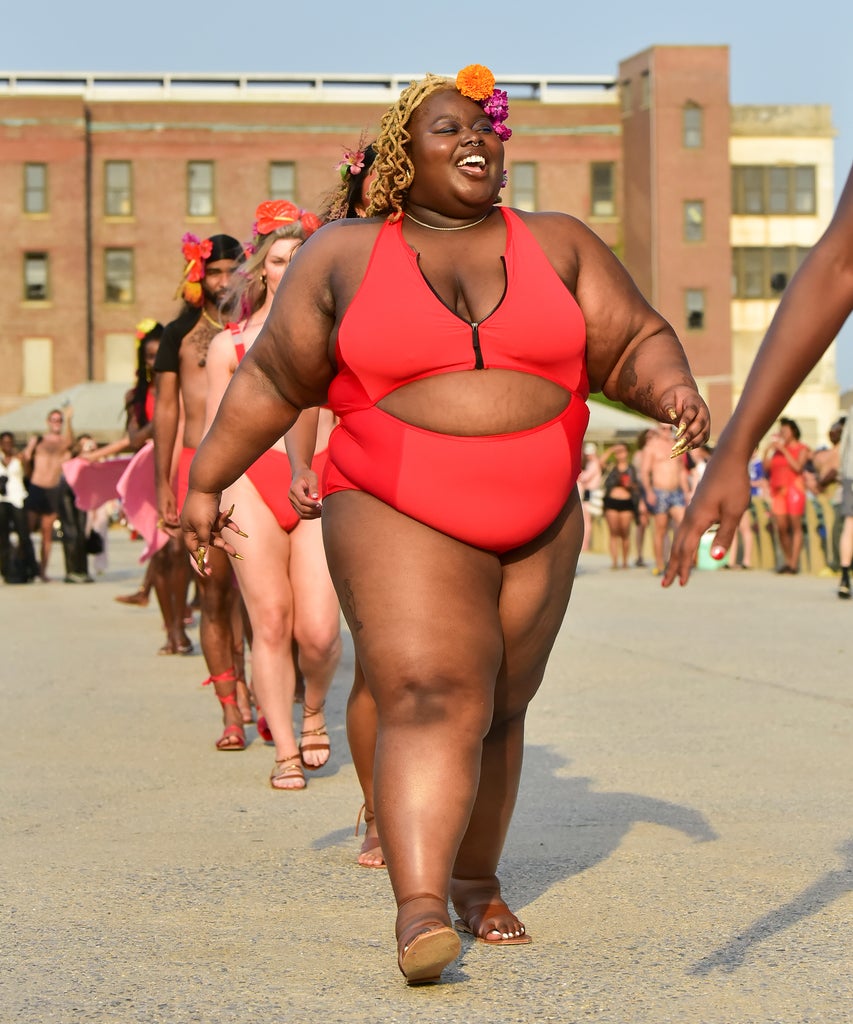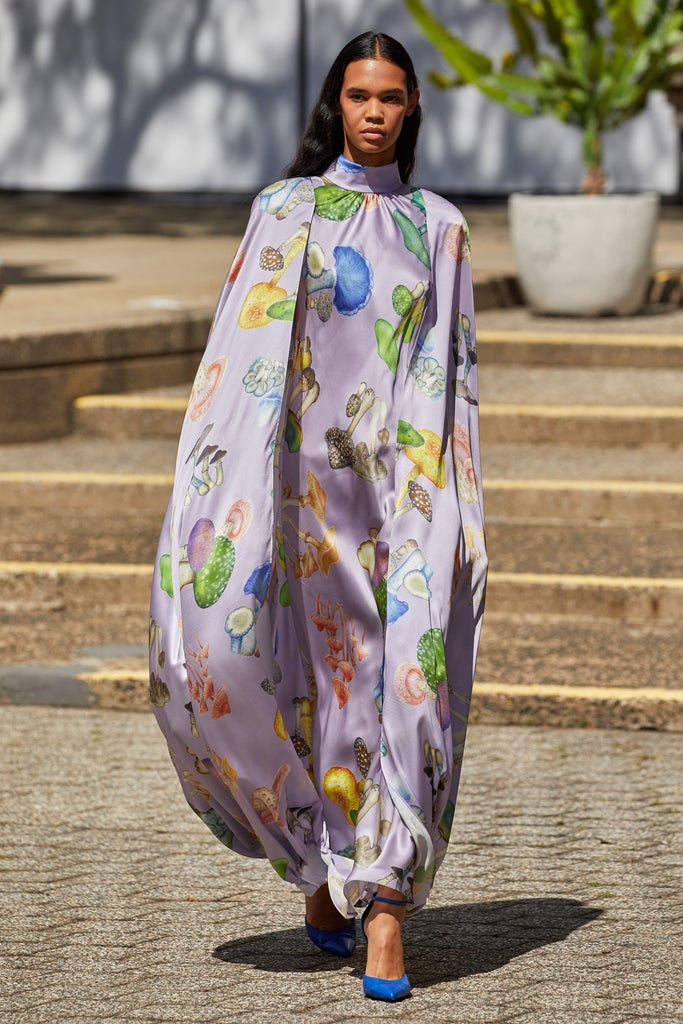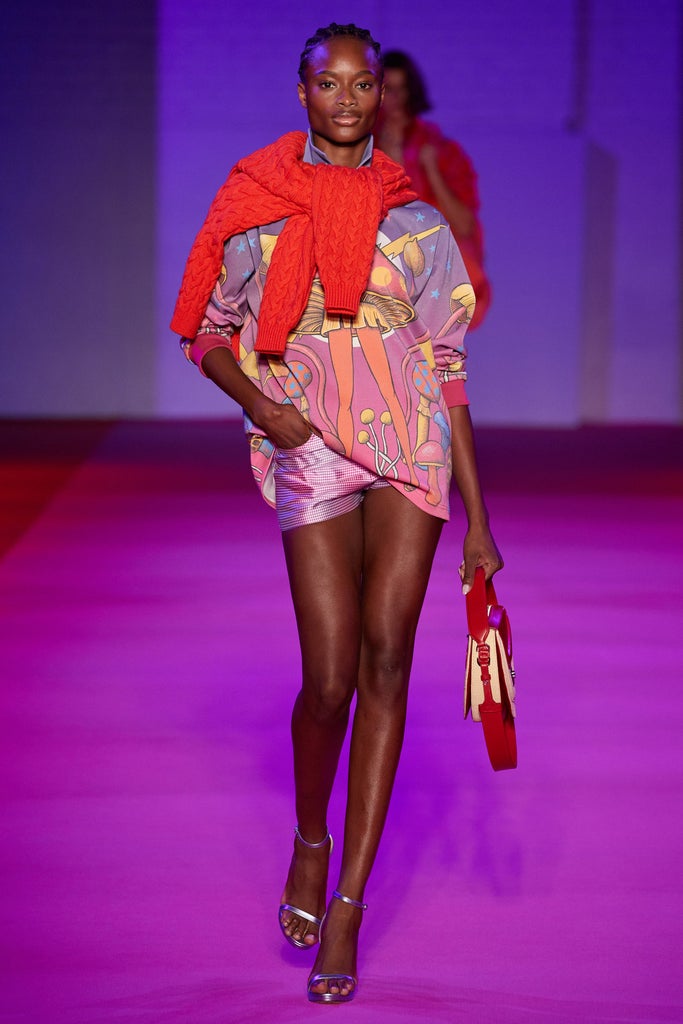
To showcase the strides made around size inclusivity at fashion week, conversations routinely revolve around the number of plus-size models on the runways. See: the most recent Fashion Spot report that states that 48 plus-size models walked during New York Fashion Week Spring 2022, a huge uptick from Fall 2021 where only six were featured. But for plus-size folk working behind the scenes, from fashion editors and photographer covering the shows to makeup artists prepping the models prior to the runways, they have yet to experience the effects of said progress.
“As much as representation is shifting, it’s hard to be in those spaces and be aware of what the [typical body] ideal still is,” says Tyler McCall, editor-in-chief of Fashionista.com. “Fashion week has a little bit of a detrimental impact on how I think of myself and how I feel about my body.”
For these people, fashion week is an obligation rather than a choice. There’s little room to take major stances on topics like body diversity when your job requires reporting across the board or getting paid to photograph runways. That means attending shows that feature inclusivity as well as those that do not. And for plus-size people in these positions, it can become difficult to separate the work from the emotion.
“It’s super disheartening because I know that this brand that I’m covering and writing about isn’t catering to me,” says Kayla Boyd, a shopping editor at BuzzFeed. “You’re in this weird position where you’re trying to judge the shows and judge the runway [collection], but you also have this thought in the back of your mind that these clothes are not made for me or people like me or people larger than me.”
Even prior to the shows taking place, there are reminders that our bodies require us to take up more space, both figuratively and literally. Fashion week benches packed closely with attendees fail to accommodate larger figures. The cramped and overfilled elevators at popular venues suggest that fat bodies are not the norm at fashion week. And gifted or loaned clothing options for the events are abysmal when you wear above a size large.
Fashion week has a little bit of a detrimental impact on how I think of myself and how I feel about my body.
Tyler McCall, Fashionista eDITOR-iN-CHIEF
McCall has made it a practice to arrive at shows early — even when they regularly begin half an hour late — to allow others to fill in beside her on the benches, rather than having to squeeze in amidst straight-size peers. “And I am aware that as a 14/16, I still have it better than other [larger] plus people do,” she says. (Statistically, the average American woman wears between a size 16 and 18.)
In 2019, model Hunter McGrady turned down over 30 fashion week jobs or shows. Inspired by her public stance against the industry’s exclusivity problem, I stopped attending non-inclusive runways as a fashion writer. I figured: If my lived experience is of no value to a designer, then my presence is unnecessary. Many editors feel similarly overlooked by designers.
“Especially with American designers, it almost feels like they’re making a point of it to not include plus-sizes,” McCall says. In particular, she views it as a “step backwards” when brands feature plus-size models one season to show none the following: “It feels intentional. The brand has proven it’s possible, and they’re just not doing it because either, best-care scenario, it doesn’t matter to them. Or, worst-case scenario, it’s distasteful to them; they’re fatphobic.”
For those who struggle with body image-related issues, fashion week can be an incredibly triggering time. The models — who are typically between a size 0 and 4 — are a constant reminder that your body, if it doesn’t fit into those sizes, is unwelcome. “It’s interesting to have your presence sort of requested, but not actually catered to as a customer,” says photographer Anastasia Garcia. “It tends to feel incredibly performative. Many designers want to be perceived as being inclusive, but they’re not actually interested in doing the work to cater to fat bodies.”
It’s super disheartening… that this brand that I’m covering and writing about isn’t catering to me.”
Kayla Boyd, BuzzFeed SHOPPING EDITOR
Then there are the plus-size hair stylists, wardrobe assistants, and countless backstage professionals who feel equally out-of-place in the fashion space. “I’m there to do my job and make other people look and feel beautiful,” says makeup artist Renee Sanganoo. “And it would be great if I saw people who look like me so I could feel as comfortable as I’m making my clients.” Sanganoo says that being the only plus-size person backstage has become so common that she rarely notices it anymore.
Plus-size photographers have a particularly fascinating role to play in fashion, capturing the beauty and elegance of an industry that intentionally keeps out anyone who doesn’t fit its archaic standards. “You’re a part of the world in the fact that you’re there to document it and observe it, and in a way, celebrate it through images, but you kind of know you’re not part of it,” says photographer Hunter Abrams. “As a photographer, I feel like an outsider, but even more so because of my body type.”
While working on assignments, photographers typically are meant to blend in behind the camera, with many choosing (or being asked) to wear inconspicuous clothing, like black suits or simple dresses. For plus-size people, sometimes the suggested dress code is not an option. At this year’s Met Gala, while shooting for Vogue, Abrams’ Willie Norris for Outlier dress stole the spotlight in the background of many celebrity images. “It’s kind of hard to fit in and wear the uniform when the uniform doesn’t come in your size,” they say.
It’s interesting to have your presence sort of requested, but not actually catered to as a customer.
Anastasia Garcia, Photographer
Not all is bleak, however. The aforementioned progress on the runways — this season, model Precious Lee dominated Fashion Month, from New York to Paris, winning the Daily Front Row’s Breakthrough Model award — and similar moments of visibility are the community-driven celebrations the plus-size fashion insiders need to keep going with their jobs.
“Despite all of his shortcomings and inherent stress that all of us are under during the week, I think that there is something really beautiful about finding your [community] at NYFW,” says Kristin Corpuz, a freelance editor and social media manager. “When you find your people who are supportive, the people who have the same values as you do, and people who are willing to be allies for minorities, I think that makes a huge difference in your experience.”
Inclusive communities like that can always be found at shows like Chromat and Christian Siriano who, season after season, prove the power of true diversity. “Everybody gets to come to the table and be exactly who they are, and it’s just very emotional,” says Jordan Bogigian, who has worked alongside designer Becca McCharen-Tran to bring the Chromat show to life for two years now. “When you are introduced to the fashion space with a brand like Chromat, you can forget that not everybody is so overly inclusive and so wonderful. It was such a great introduction [to what the future of fashion could look like].” For their part, many plus-size photographers — including Garcia, Abrams, and Lydia Hudgens — are making a point to specifically capture fat beauty whenever possible. Imagery that is reflective of the very people this industry has long rejected.
Fashion week may never prioritize true inclusivity in the way many of us crave. But that won’t stop those behind-the-scenes from pushing to create room for acknowledgment of our lived experiences.
“Ten years ago when I first started, these realities [of inclusivity at fashion week] weren’t even fathomable, so it’s wonderful to see,” Garcia says. “You can’t imagine yourself in a situation or in a role until you’ve seen someone else do it. And so when you see a runway show, or you see a fashion photograph celebrating somebody of a larger size, it gives people permission to love themselves.”
Like what you see? How about some more R29 goodness, right here?
Viral TikTok Trends Rarely Come In Plus-Sizes


